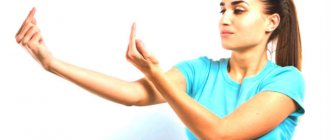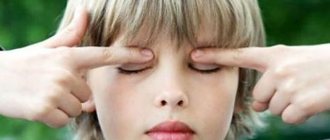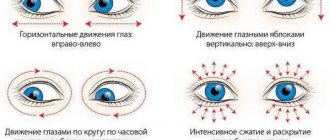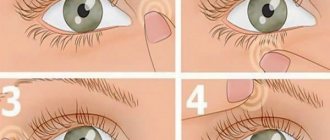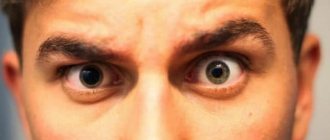Working out at the gym is essential for maintaining a healthy weight, preventing heart disease and lowering cholesterol, but how many people exercise for eye health?
It's a little-known fact, but exercise can also protect against eye diseases and vision loss.
Research in this area is just beginning, with recent research showing that exercise may provide protection against cataracts, the world's leading cause of blindness.
The effectiveness of exercises for cataracts
Cataracts form when the lens of the eye becomes opaque and leads to poor vision. Most often the disease affects older people. While it's not entirely clear exactly how the supplements help with cataracts, doctors say exercise increases high-density lipoprotein (HDL), commonly known as "good cholesterol."
One study compared the physical activity levels of patients without cataracts with those of patients with cataracts. Patients with little to no physical activity were 7 times more likely to develop cataracts than those with moderate levels.
In another study, researchers found that runners who ran more than 64 km per week were 35% less likely to develop cataracts than runners who ran less than 64 km in the same period.
Exercise improves blood flow and circulation in the eye tissues and helps flush out toxins. Increasing your intake of vitamins A, E and C will help keep your eyes healthy. Flaxseed oil and omega-3 fatty acids and other key nutrients for healthy vision and cataract prevention.
However, just proper nutrition is not enough. It is necessary to perform gymnastics for the visual organs and play more sports.
They cannot cure diseases, but they can improve vision, strengthen the eyes and relieve stress. Eye health is one of the most important aspects of the human body, and regular exercise will help maintain the visual organs and allow them to function fully. Improve blood flow, have a positive effect on muscle tone and the lymphatic system.
Contraindications to gymnastics:
- retinal disinsertion;
- the last stage of myopia;
- surgical intervention;
- injury;
- infection or inflammation.
After the infection and inflammation have stopped, you can perform the exercises. After surgery, you should refrain from using them for 1 week or until the tissues have completely healed.
Tibetan gymnastics
Improve vision with a complex aimed at strengthening and improving eye disorders that can be aggravated by daily and chronic stress, tension and anxiety.
Special gymnastics was developed by Tibetan monks. It is designed to stimulate the muscles and optic nerves. Doing one or all of the exercises twice a day may improve vision problems over time.
Remove glasses and contact lenses before performing the complex. Wash your hands with antibacterial soap, paying special attention to the area under the nails and between the fingers.
Complex:
- Bend your arms at the elbows, place your index fingers on the sides of the bridge of your nose. Fix your gaze on them. Slowly move your arms to the sides, continuing to watch your fingers. This helps improve peripheral vision.
- Rotate both eyes clockwise. Look at the eye chart and rotate in the outer circle. Repeat, moving in the opposite direction.
- Move your eyes back and forth between the numbers 2 and 8 on the dial. Then between the numbers 4 and 10.
- Hang green paper next to your computer. Stop working from time to time to look at it for 5-10 minutes. Green relaxes the eyes and calms the nervous system.
- The gymnastics ends with a quick blink.
Repeat as needed, avoiding extreme fatigue. After completing the complex, do not immediately put on glasses or contacts.
Tibetan technique for developing peripheral vision
Other names for this technique are astral and “clear vision method.” With the help of basic exercises that are easy to perform both at home and at work, you can achieve significant success in the development of peripheral vision. The result can be assessed after a month of regular training. The main tool of the Tibetan clairvoyance technique is an ordinary pencil. The training scheme remains unchanged, all that remains is to observe how much clearer and sharper the lateral vision becomes.
Tibetan technique for developing peripheral vision
- Take a pencil in each hand and, holding them vertically, fold them together. Pencils should be at eye level at a distance of 30 cm from the face. Focus your gaze on something behind them. Pencils should be on the periphery of vision and at the beginning of training their outlines will be blurry.
- Slowly move the pencils away from each other, spreading your arms out to the sides at the same level. Increase the distance until the pencils are on the right and left borders of your field of view.
- Slowly bring your hands together again until the pencils are in the starting position. Don’t try to do it faster; slowness is the key to the effectiveness of this particular workout. During all manipulations, continue to look at the same object as at the beginning of the exercise; it is very important not to shift the focus to pencils or hands. Repeat mixing and spreading at least 10 times.
- Return the pencils to their original position. Slowly lower one hand with a pencil down, and lift the other up until they reach the upper and lower boundaries of the viewing sector. Vision, as in the previous case, focuses on an object in the distance. Repeat at least 10 times.
- From the starting position, move your right hand with a pencil diagonally up, your left hand down until they reach the boundaries of your vision. After 10 repetitions, change direction - the left hand moves up, the right hand down.
- The last exercise is to return the pencils to their original position and, without moving them, mentally enclose them in a circle. Outline this imaginary circle with your gaze, first clockwise, then in the opposite direction. Repeat at least 10 times. Remember that your gaze should not focus on the pencils!
Together, these exercises allow you to train peripheral vision in all directions. At the beginning of training, the outlines of the pencils will be blurry, but every day you will see them more and more clearly.
Tibetan graphic symbol for the development of peripheral vision
Another simple and effective way to increase the acuity of lateral vision, gifted by the Tibetans - the so-called. Tibetan graphic symbol. You can practice by contemplating this symbol on the computer screen, but it’s easier to print it out in good resolution.
- Starting position: sit on a chair, back straight, back muscles relaxed. The symbol is located at a distance of 15 cm at eye level.
- Place your palms together in a bowl shape and gently place on the eye area, without touching the eyeballs, for 60 seconds. Then remove your hands from your eyes.
- Looking at the symbol, make circular movements with your eyes, enclosing it in a circle BEHIND the points marked in the picture. Draw the circle first clockwise for 30 seconds, then counterclockwise for the same time.
- Visually superimpose a clock face on the symbol (the dots should be in place of the numbers 12, 2, 4, 6,8 and 10). Move your gaze diagonally from points “2” to “8” for 30 seconds, then repeat the same with points “4” and “10”.
- Blink a few times and cover your eyes with your palms. Symbol training is complete.
Tibetan gymnastics helps to thoroughly strengthen the eye muscles
If you wear glasses or contact lenses, they should be removed during peripheral vision training. Regular use of the Tibetan techniques described above allows you to achieve not only a significant increase in visual acuity, but also thoroughly strengthen the muscles of the eye.
According to Zhdanov's method
It is recommended to perform this complex at least 3 times a day. It is performed during treatment and for prevention.
The Zhdanov complex involves drawing objects with the eyes in empty space. It is recommended to do the following:
Blink after each exercise. The tasks are performed 5–6 times each in 1 approach. The ophthalmic exercise is completed by blinking. Then you need to lie down with your eyelids closed, relaxing as much as possible.
Benefits of exercise
Gymnastics for cataracts has a beneficial effect on the morphological and functional state of the eyes. When performing exercises, a number of effects are noted:
- improvement of microcirculation in the vessels of the eye organ;
- normalization of tissue metabolic processes;
- eye muscle training.
These effects can slightly improve visual acuity with cataracts, as well as slow down its progression. Gymnastics for the eyes is also useful for other eye pathologies, as well as for prevention.
Tibetan
It is recommended to perform Tibetan eye gymnastics for cataracts in the morning after waking up. Sequence of Tibetan exercises:
- Alternately close your eyelids and then relax them several times.
- Apply gentle pressure to closed eyelids with your fingertips.
- Close your eyelids, place your fingers on them, and try to open your eyes. Your fingers should offer resistance.
- Make several circular movements over the surface of your closed eye.
- Follow with your gaze the finger approaching your nose and moving away from it.
- Blink for 30 seconds.
At the end of the gymnastics, wash your face with cool water. Lie down for a few minutes with your eyelids closed.
Video about Tibetan eye gymnastics for cataracts:
Zhdanov's technique
Exercises for cataracts according to Zhdanov are performed at any time, the main thing is daily.
- Fix your head in a stationary position. Move your eyes left and right, then up and down. After this, blink frequently. Perform the exercises 5-6 times.
- Using your eyeballs, draw a plus sign, a rectangle, a circle (clockwise and counterclockwise), a spiral, a wave several times.
- Blink, then lie down with your eyelids closed.
According to Norbekov
The effect of gymnastics according to Norbekov appears after several weeks of daily exercise. The order of performing eye exercises for cataracts:
- Close your eyelids. Swipe your eyeballs from bottom to top, left to right.
- Draw the number 8 with your eyeballs.
- Place 2 index fingers in front of your face and fix your gaze. Start slowly spreading your fingers in different directions, while trying to hold your gaze for as long as possible.
- Rest your eyes by closing your eyelids.
To view gymnastics for the eyes according to the Norbekov system:
Yoga
The essence of yoga is to bring the psychological and physical state into balance. To do this, control your thoughts and breathing while doing eye exercises for glaucoma, cataracts and other pathologies of the eye organ.
Breathing should be uniform, of medium depth, calm. Try to fill your thoughts with positive pictures or discard them altogether.
- Fix your gaze on the point between your eyebrows, then shift your gaze to the tip of your nose. Hold at each point for 10 seconds.
- First with your eyes closed, then with your eyes open, move your eyeballs along an imaginary circle. 7 times in one direction, the same number in the other.
- Draw imaginary lines with your gaze: from right to left, from bottom to top, diagonally. Then change direction to the opposite. Draw each line 7 times.
- Watch the candle flame. Sit in a dimly lit room, straighten your back, relax tense muscles. Open your eyelids wide and look at the fire. Try not to blink for as long as possible. After you blink, close your eyes and blink. Repeat several times. Increase the duration of the exercise to 15 minutes.
- Finally, blink rapidly for 30 seconds.
To view yoga for the eyes:
Palming
Before starting the procedure, warm your palms and sit comfortably with your back straight. Cover your eyes with your palms, clasping your fingers tightly. The flow of light must be completely blocked. You need to stay in this position for 10 minutes.
You can perform the relaxing Palming technique to relax after other types of gymnastics. Palming allows you to relieve tension from tired eyes. It also prevents the development of cataracts.
Watch a practical video about palming:
Morning work-out
Morning preventive exercises to prevent cataracts and other ophthalmopathologies are performed immediately after waking up from a night's sleep. Perform each exercise 5–10 times. Charging steps:
- Alternately open one or the other eyelid.
- Open both eyes wide.
- Blink for 30 seconds.
- Close your eyes tightly, then relax.
- Write your name with your eyes closed and open.
- Raise your eyebrows as high as possible, then relax.
- Blink your eyes and do a relaxing palming exercise.
Yoga as an effective remedy against cataracts
Yoga asanas are known to improve organ function. She has a number of exercises that can improve eye function. These complexes will help overcome various problems associated with the organs of vision, such as myopia and farsightedness.
With the exception of a few diseases such as glaucoma and cataracts, which are caused by bacterial infections, many eye disorders are associated with muscle problems that can be caused by chronic mental and emotional stress. Yoga techniques help relieve such disorders.
Yoga asanas for the treatment of cataracts:
- Downward facing Dog Pose helps in the initial stages of the disease. Get on all fours, placing your palms on the floor. Tuck your toes, press your hands firmly to the floor. As you exhale, lift your buttocks and tailbone toward the ceiling, bringing your body into an inverted “V.” If not as flexible, keep your knees slightly bent. Otherwise, press your heels to the floor and straighten your legs. Expand your chest and squeeze your shoulder blades together. Relax your head and neck and lengthen your spine. Keep your weight evenly distributed between your legs and arms. Hold for a few breaths, then release your hands and knees.
- Get on all fours on a soft surface. Place your forearms on the floor and relax your arms. Slowly lower your head to the floor, clasping your hands. The top of the head should lie on the floor. Shift your weight forward, first into your hips and torso, then into your head. Raise your right leg, then your left, straight up. Hold weight, balance on forearms and head. Remain in this position for 30 seconds.
- Bent candle pose. Place a pillow or folded blanket next to the wall. Lie down, raise your legs up, touch the wall. Pull your socks towards you, spread your arms to the sides. As you exhale, swing your legs.
- Sit down with your legs straight. Raise your arms, keeping your fists clenched and your thumbs up. Look at a point in front of you at eye level. Breathe evenly. Keeping your head in a fixed position, move your vision to the space between the eyebrows, left thumb, space between the eyebrows, right thumb. Repeat the exercise 10–20 times.
- Sit down with your legs straight. Place your left hand on your left knee. Hold your right fist over your right knee, pointing your thumb up. Keep your elbow straight. Next, without moving your head, focus your gaze on your thumb. Make them a circle. Repeat the process, focusing on the left finger. Close your eyes, let it rest and completely relax. During the exercise, pay special attention to breathing.
After completing all the above exercises, lie down in Shavasana (corpse pose) for a few minutes and completely relax. Breathe softly and slowly, do not resist.
Exercises to relieve tension and improve microcirculation
If cataracts cause fatigue and tension, a different complex will be required. Here are 8 exercises for eye health and improved vision:
- Perform rotations in both directions 5 times.
- Refocusing. Shift your gaze from an object located at a far distance to a close object.
- Blinking. Close your eyes for 2 seconds, open and blink quickly for 5 seconds. Repeat 5 times.
- Rule 20-20-20. Every 20 minutes you need to look at something located 20 cm from your face for 20 seconds.
- Look straight ahead, then up without moving your head, and then down. Do 10 approaches. Then look right, left.
- Scaling. Sit in a comfortable position, extend your arm, raise your thumb. Focus on your thumb and move it closer to your face until it is 3 cm from your eyes. Concentrate and slowly return to the starting position. Do this several times for 2 minutes.
- The figure eight is an excellent exercise for increasing muscle flexibility. Looking at a blank wall, imagine a large number 8 tilted to one side. Now draw the number with your eyes without moving your head. Do it one way, then the other way.
- Cup your hands over your eye socket to apply gentle pressure. Keep your eyes closed and look into a dark space. Maintain pressure until all residual tones disappear. This exercise will help restore vision, moisturize the mucous membranes, and give the eyes rest and relaxation. Perform for at least 30 seconds. Warm up your hands before the exercise.
Exercises for eye diseases
Tibetan healers' approach to treating eye diseases is based on Eastern philosophy, which compares vision to fertile soil that depletes over the years. Just as the soil needs fertilizer to maintain fertility, the optic nerves need constant stimulation to function properly.
Green color relaxes the eye muscles. Place a flower or green objects near your computer monitor. Periodically look at them. Your eyes will be less tired.
Exercises for glaucoma
Increased intraocular pressure, characteristic of glaucoma, is removed by muscle relaxation, special exercises and massage:
- Change of focus. For 15 seconds, alternately focus your gaze first on the fingers of your outstretched hand, then on the object that they overlap.
- Fixation of gaze. For 15 seconds, look as far to the right as possible, then to the left, as if you want to see your ear, then up - attention to the top of the head, down - attention to the chin.
- Eight. Watching the movement with your eyes, draw the number eight on your palm with your nose.
- Massage. With eyes closed, massage from the bridge of the nose, under the eyebrows, medium pressure. If you wet your hands with cool water, the relaxation effect will be stronger.
